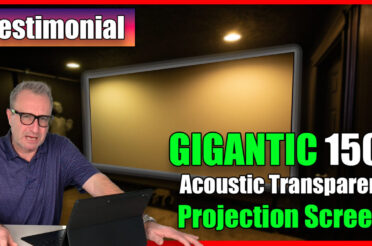By Dave Rodgers (Marketing Manager of Elite Screens Inc.)
“When is it appropriate to buy a matte white or an ambient light rejecting projector screen?”
Ambient light rejecting (ALR) projector screens have been the hot trend in projector screen design. What started as a “must have” for custom installers has become an industry norm even among CE Retail consumers shopping the “big box” store brands. As an industry technology writer, I like ALR screens more than I like matte white entirely because of all the tech that went into developing such a complicated, yet simple material that does so much. That said, the soft spot I have for consumers compells me to hate it when they are oversold on an installation where a matte white screen would have done just fine. So which is best for your application? The versatility of matte white versus the precision excellence of ALR projector screens; the choice is ultimately yours but here are some points to help you with your decision.
What’s the difference between “Matte White” and “ALR”?
Matte white is still the most common type of projector screen on the market today. It typically has a 1.0-1.2 gain classification. Gain is the measure of a projector screen’s ability to make a projected image brighter/duller. Matte white screens make up the neutral medium of gain that is around ±1.0 gain. Magnesium carbonate (MgCO3) is the accepted control point of 1.0 gain against which the brightness of projector screens is typically compared. Because it is the measured point of dynamic range that comes the closest to “pure white”, magnesium carbonate is typically an essential ingredient in the manufacture of matte white projector screens also.
Fig. 1: Illustration of a centered projector placement versus off axis to either the right or left
The advantages of matte white screen materials are versatility and cost. Matte white screen materials are versatile because of their wide diffusion uniformity which means that an equal amount of brightness will be reflected into a viewer’s field of vision regardles of how far centered or off axis (fig. 1) their viewing angle is. Due to the low-cost and ease of construction, matte white projection screens are much cheaper to make. Because of this, matte white projector screens are preferred as long as there is a control over ambient light in your projection environment. They are also compatible with standard, short throw or UST projectors.

Fig. 2: Shows an over exposed image to demonstrate the washout effects of ambient light
The disadvantages of matte white projection screens are that they are easily washed out by ambient light and they do little to enhance image brightness and/or contrast. Ambient light is essentially all the light in your projection environment that is not coming from your projector. Because matte white screens do so well at uniform diffusion, it also means that it will reflect ambient light and that is how room lighting “washes out” your projected image (Fig. 2). In addition to this, matte white is neutral so it does little to enhance contrast with either the dynamic range of black levels or color. Any necessary enhancements to color temperature, saturation or black levels are left entirely up to the projector and its end-user’s ability to calibrate it properly.
Ambient Light Rejecting (ALR) can filter out ambient light to provide television panel brightness regardless if the lights are on or off. They typically consist of a highly reflective base layer topped with diffusion layers that filter out off-axis light while enhancing the picture’s dynamic range. This can make the image brighter; colors more vibrant; and black levels more defined (as seen in Fig.3). In the case of angular reflective ALR screens like the CineGrey 3D®, the reflective base compresses the brightness into a narrower “half-gain cone” which in turn enhances the picture’s luminescence. Its outer diffusion layer gives the screen material a gray appearance. ALR screen appears gray to our eyes because it is filtering out the ambient light from the room. Since a white screen doesn’t filter out ambient light, we see it as white projection surface. The ALR screen filters most of that light out leaving us with a gray projection surface to look at. This is why these ALR projector screens are are commonly referred to as “Grey”, “Dark” or “Black” screens.

Fig. 3: Shows an ALR screen material rejecting high levels of ambient room lighting
Characteristics of an angular reflective ALR screen
Angular Reflective means that light reflects off the surface at precisely the opposite angle of incidence exactly as the laws of reflection describe and as the diagram below illustrates.
Fig. 4: Illustration of how an Angular Reflective ALR screen works
This type of screen is the preferred model for residential and commercial applications. The material prevents full diffusion from occurring to provide greater control over the washout effects of ambient light. The focused reflectivity rewards viewers with a bright projected image that achieves a superb level of color temperature. At the same time, off-axis light is diverted away from the viewer’s range of visible perception. Its multiple layers of diffusion material further negates the washout effects of ambient light while also enhancing black levels for sharp image clarity.
Advantages of the Cinegrey 3D® ALR projector screen,
include the ability to have a bright and beautiful big screen image with the lights on or off along with superb picture performance. It is certified by the Imaging Science Foundation (ISF) for accurate color points, color temperature and dynamic range. It provides a flat spectral response for an accurate color balance in dark room environments as well for reference quality applications. The CineGrey 3D® is ready for the next-generation of high-performance 4K/8K UHD video applications.
The disadvantages of the Cinegrey 3D® ALR projector screen,
are that it has a limited half gain cone of 45° and is not compatible with short-throw or ultra short-throw projectors. The screen has a left-right half gain cone of 90°. This means that viewers who are more than 45° off axis to either the left or right will not get the same brightness and picture clarity. Although this is not ideal for a large backyard event, it’s perfect for home theater and hospitality industry (resorts, clubs, and restaurant) applications. Because of its ambient light rejecting properties, it will not allow off-axis light to be that visible. Since short throw and UST projectors present an off-axis light signal, the ALR material will disrupt the image.
How to properly use the Cinegrey 3D®
Be sure that the projector is properly centered (as seen in Fig. 1) in either a ceiling mount or table mount installation. Make sure that ambient light sources such as flood lights or windows should not be behind the projector. Ambient light coming from the same direction as the projector will appear on the screen. These screens are designed to bring a larger than life image with TV quality brightness to your business or work space regardless if you leave the lights on or not.
In a Nutshell
ALR screens like the Cinegrey 3D® vastly outstrips the performance of matte white screens with superior brightness while filtering out ambient light. The end result is that is creates a realistic image that allows high-resolution content to be appreciated in its full glory with the lights on or off. Color is more vivid and high resolution (UHD and 4K) content is more defined. A quality video presentation is as sensual an experience as fine wine or a gourmet meal. So indulge your eyes to the best in high end visual performance. They work hard for you so be good to them.
About the Aeon CineGrey 3D®
CineGrey 3D®is a reference quality front projection screen material formulated for environments with minimal control over room lighting. It was designed to enhance picture brightness, offer accurate color fidelity, and improve contrast levels. The CineGrey 3D®is best for family rooms, educational facilities, conference rooms or any applications in which incident light is a factor. Typical matte white surfaces wash out the images when ambient light cannot be controlled. The CineGrey 3D®is the best choice for having a projected image with a balanced color temperature and contrast under such conditions.











